Maintenance, checks: how to prepare your motorcycle for sunny days

Take the motorcycles out of the garages: the beautiful days are back! But before going to tease the asphalt and investigate the turns, some checks and maintenance operations on your two-wheeler are essential.. All the MNC tips and tricks in our Spring Review Special Practical Guide.
Placing and removing your motorcycle from winter storage: instructions for use
While many bikers use their motorcycle all year round, others prefer to leave it in the garage during the winter while waiting for the warmer weather to return. For questions of comfort and obvious reasons linked to the climate, in particular for the inhabitants of the northern part of France: riding two-wheelers on icy roads, sometimes snowy, bundled up in several layers of clothing, is enough in "cooling" more than one !
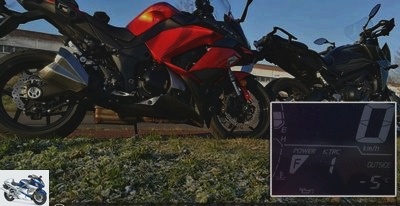
Motorcycles generally cope well with this wintering period, especially recent injection models. However, on condition that you spend the winter sheltered from the elements: it is different for two-wheelers left abandoned in the street from October to March! Storing your motorbike or scooter in a dry place and if possible frost-free is one of the keys to restarting without any unpleasant surprises in the spring..
- MNC practical guide :
Other procedures to follow to facilitate restarting after wintering: disassemble the battery and store it warm – or at least disconnect its cables – and fill the fuel tank to the brim to prevent oxidation of its walls. For motorcycles with carburettors, generally old or off-road models, it is better to drain everything: reservoir, carburetor (s) and fuel system. Finally, will prevent rust formation during storage.
However, even motorcycles carefully wintered must be inspected in fine weather in order to verify their perfect functioning: MNC gives you the advice to follow and the maintenance procedures to be carried out at the end of winter in three fundamental steps. follow the guide !
1 – Check and maintain your motorcycle battery
First step after a long period of immobilization: reassemble or reconnect the battery, the charge of which will have been taken care of beforehand using a voltmeter or a multimeter. As unused batteries gradually discharge, recharging will probably be necessary after winter. Except for batteries whose power will have been preserved during wintering thanks to an automatic charger with charge maintenance function, preferably specific to motorcycles (those for cars are often too powerful).
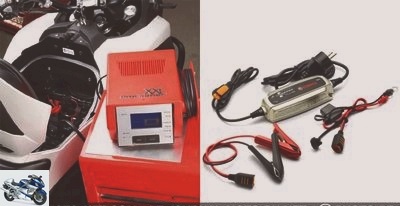
This type of charger is relatively inexpensive (between € 40 and € 80, approximately) and can often be connected to the battery without having to disassemble it. Practical to avoid soft shots on restart! For maintenance-free batteries, the majority on motorcycles after 2000, no other procedure is necessary: this is precisely the point of "maintenance-free".
These non-openable batteries are black-sided, as opposed to "conventional" batteries whose walls are transparent to facilitate monitoring of the liquid inside (the electrolyte). If the level of this liquid is below the indicated threshold, open the cap (s) and top up with distilled water. When reconnecting the cables (starting with the "+" terminal), brush the terminals and apply a little grease to prevent the formation of crystals and corrosion..
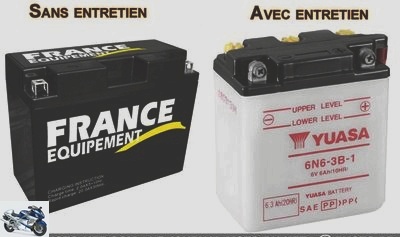
Batteries have an estimated lifespan of two to three years: by following these maintenance procedures, it is possible to significantly extend their lifespan. The original battery of a Japanese sports motorcycle from MNC’s editorial team thus lasted no less than ten years before showing its first weaknesses. !
2 – Visual checks, chain tension and levels
Then carry out a general inspection of your motorcycle for any anomalies: oil leaks, loose nuts, frayed cables, oxidized lugs, etc. Check that all controls and lights are working properly, including the license plate light and turn signals. The levers should actuate the clutch and front brake precisely, without excessive stiffness or softness. Same thing for the rear brake pedal.
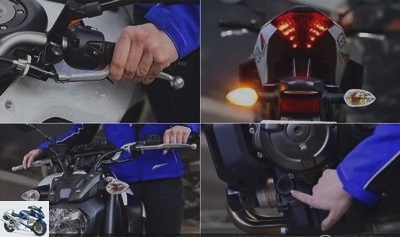
Spray a WD40 type protective lubricant on the connectors, threads, cables, screws and joints (pedals, kickstand, selector, footrest). In this way, a water-repellent and penetrating film will be deposited on these components. Also check the proper functioning of the steering column bearing, which must not have any hard points by placing the handlebars to the stop on one side then the other. In the opposite case, a change is unfortunately to be expected..
For motorcycles with chain drive, the chain must be in good condition and properly tensioned, with about 3 cm of free travel (the "arrow" is specified on the maintenance manual and sometimes on the swingarm). Its good lubrication must also be ensured, even if lubrication was carried out before wintering, because the O-rings and the grease they retain have had plenty of time to dry..

For motorcycles with acatene transmission (belt or cardan shaft), a minimum of observation is required. The belts acclaimed on custom type motorcycles also wear out, admittedly less quickly than a chain, but check their degree of wear and especially the absence of foreign bodies and cracks. As for the gimbals, they only require an oil change at around 20,000 km (variable interval depending on the makes and models).
Also check all fluid levels: engine oil, gear oil, coolant and brake fluid. These levels can be checked easily, when cold, by means of a dipstick or a sight glass for the engine oil and "Mini" / "Maxi" marks for the brake fluid (on the jars) and cooling (on the expansion tank).
Remember that an engine oil change is recommended once a year even if the recommended mileage is not reached, because the oil loses its qualities as it ages. The recommended interval varies from 6,000 km to 15,000 km depending on the motorcycle. For the same reasons, replacing the coolant and brake fluid is recommended between 24 and 36 months of use..
3 – Inspection and maintenance of suspensions, brakes and motorcycle tires
The suspensions must on their side sink in and return to their place smoothly. Check the dip tubes for scratches and dirt, causing oil to leak. Clean them with a degreaser, then dry them to improve their sliding. Changing the fork approximately every 20,000 km preserves its damping qualities: it would be a shame to deprive ourselves of it given the importance of the front axle on driving a motorcycle !
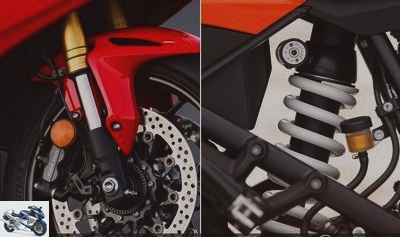
At the rear, the spring (s) do not require any special maintenance. On the other hand, the ball joints and rods – for motorcycles which are equipped with them – must operate smoothly: spray lubricant to extend their life. After 50,000 km, the performance of the spring (s) decreases mechanically: in addition to the resulting degradation in comfort, the motorcycle’s handling is also affected. It’s time to fall for a better quality adaptable !
In terms of braking, the main check concerns brake pad wear. Do not neglect this check, especially when restarting in the spring: used pads no longer provide a correct braking function, in addition to damaging the disc because it rubs directly on their metal support. The condition of their lining can be measured visually, possibly using a lamp and a mirror to observe from below: below 2 mm thick, the pads are good to change !
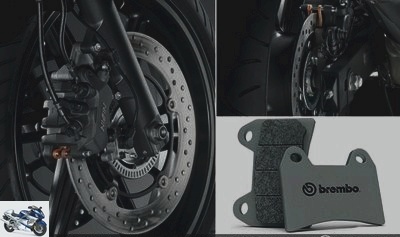
To facilitate this check, most plates have one or more notches to indicate the minimum thickness to be kept. Other wear indicators: a significant drop in brake fluid in the reservoir located near the master cylinder (usually above), causing a spongy control. Take the opportunity to check the condition of the hoses by tracking down leaks, cracks and signs of friction, symptomatic of a bad passage of the hose. The discs also wear out: check that their track is not too deep (the minimum thickness is written on the disc and on the maintenance manual).
Finally, it is imperative to check the general condition, wear and tire pressure of your motorcycle before attacking the beautiful season. Start by inspecting the tread and sidewalls for any cuts, bends, or tears. Remove any stones stuck in the tread, then check their depth: the highway code requires grooves of at least one millimeter on "four points distributed evenly around the circumference of the tire".
- MNC practical guide :
Then check your tire pressure when cold: it is generally 2.5 bars at the front and 2.9 bars at the rear. These standard pressures can be adjusted to suit the bike and conditions. Thus, apply the "high" range of the recommendations with a heavy road bike, especially before a long trip with a duo and loaded suitcases. The tire pressure of a sports motorcycle – lighter and often used solo – can conversely be lowered, by around 0.3 bar maximum..

Remember that insufficient pressure causes premature wear of the tire, a noticeable increase in fuel consumption and less precise directional control. On the other hand, over-inflation makes the motorcycle less comfortable and more unstable: handlebar phenomena, for example, are amplified by excessive pressure..
Papers and equipment in order to restart the season
Your spring motorcycle check-up is now complete! Before leaving for a ride on the roads, remember to check that your insurance certificate and the badge to be stuck on the motorcycle are indeed those of the current year (we no longer count the bikers traveling with documents of the year previous!) and that a mandatory yellow vest is slipped under the saddle…
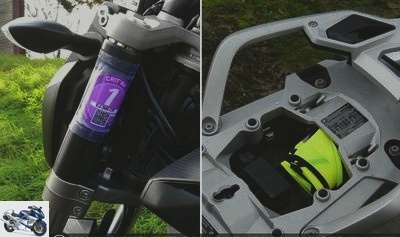
In the chapter "obligations", Parisian bikers and those circulating in the streets of the capital will not forget to affix their Crit’Air sticker on their motorcycle, so as not to start the beautiful season with a plum! Also keep in mind that the wearing of approved gloves is mandatory for the driver and any passenger. In winter, the risk of forgetting is low, but with the return of sunny days…
- MNC of May 11, 2015 :
- MNC of January 6, 2017 :
- MNC of September 20, 2016 :
Related articles
-
Practical guides – Motorcycle tires: practical advice for riding well –
Motorcycle tires: practical advice for driving well Too often neglected by motorcyclists, the tire supports substantial constraints which vary according…
-
Practical guides – Practical motorcycle guide: how to choose your rain gear? –
Practical motorcycle guide: how to choose your rain gear ? Small shower, simple downpour or heavy rain: rain can occur at any time during your motorcycle…
-
Practical guides – How to choose your motorcycle travel bag? –
How to choose your motorcycle travel bag ? Carrying all your motorcycle equipment in a travel bag requires paying attention to various criteria such as…
-
Motorcycle maintenance: the main points to check
September 25, 2018 You’ve invested in getting the license and just bought a shiny motorcycle. Now it’s up to you to pamper her. A two-wheeler without…
-
How to choose the right motorcycle or scooter 125 ? Tired of traffic jams or the metro, motorists and transport users turn to the 125. On what criteria…
-
Mistakes not to make when buying or selling a used motorcycle
January 11, 2019 Even for new bikes straight out of the factory, the future owner won’t have to buy with their eyes closed, especially if the transaction…
-
Practical guides – All practical motorcycle and scooter Guides Moto-Net.Com –
All Motorcycle and Scooter Practical Guides Site Advice on choosing your motorbike or scooter, renting a motorbike, traveling in Europe on a motorbike,…
-
How to choose the right motorcycle or scooter 125 ? Tired of traffic jams or the metro, motorists and transport users turn to the 125. On what criteria…
-
Motorcycles in winter: how to ride in the cold ? How to equip in winter? What protections against the cold? Discover the tips and essential equipment to…
-
How to choose the right motorcycle or scooter 125 ? Tired of traffic jams or the metro, motorists and transport users turn to the 125. On what criteria…